News & announcements
Saving your history
Early accounts
Maps
Nearby towns
People
Churches
Schools
Municipal
Organizations
Businesses
The mines
Transportation
Streets
Buildings
Entertainment
Celebrations
Sports
Ethnic groups
St. Mary's Byzantine Catholic Church - early view
Early views of St. Mary's Byzantine Catholic Church
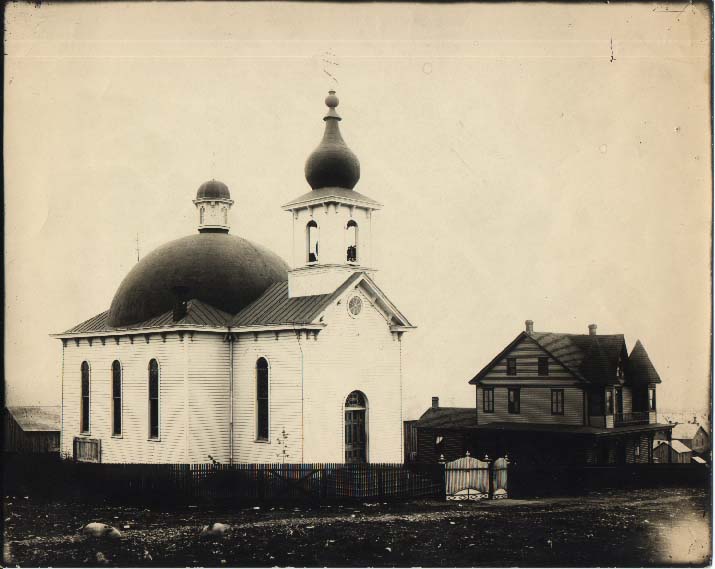 St. Mary's, known for years as the "Greek Church,"
was founded in 1887 by immigrants who came chiefly from the
Carpatho-Rusyn area of Slovakia and probably also Ukraine. This photo
came to me from John Zubach, and is evocative of very early Freeland.
This architecture was unlike that of any other church in town, with
its exotic combination of a large round dome and a steeple topped with
an onion dome and Byzantine-style cross with its three cross-bars, the
bottom bar pitched on a slant. These crosses are found on both Eastern
Orthodox churches and Eastern Catholic churches in the Byzantine rite.
It looks to me like this photo is early enough that the building that
the students on a related page were standing in front of in 1896 had
not yet
been built to the left of this church. The fence around the church is
also interesting, with its gates of a very eastern European style. A
number of Freelanders kept livestock in the early years of the town,
and my brother and I speculate that this church fence was made in part
to keep out livestock wandering in the area. I wonder if the rather
elegant building to the right of the church could have been the
original rectory.
St. Mary's, known for years as the "Greek Church,"
was founded in 1887 by immigrants who came chiefly from the
Carpatho-Rusyn area of Slovakia and probably also Ukraine. This photo
came to me from John Zubach, and is evocative of very early Freeland.
This architecture was unlike that of any other church in town, with
its exotic combination of a large round dome and a steeple topped with
an onion dome and Byzantine-style cross with its three cross-bars, the
bottom bar pitched on a slant. These crosses are found on both Eastern
Orthodox churches and Eastern Catholic churches in the Byzantine rite.
It looks to me like this photo is early enough that the building that
the students on a related page were standing in front of in 1896 had
not yet
been built to the left of this church. The fence around the church is
also interesting, with its gates of a very eastern European style. A
number of Freelanders kept livestock in the early years of the town,
and my brother and I speculate that this church fence was made in part
to keep out livestock wandering in the area. I wonder if the rather
elegant building to the right of the church could have been the
original rectory.
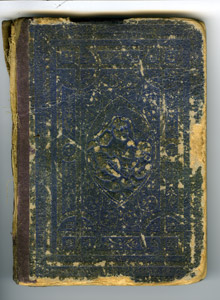
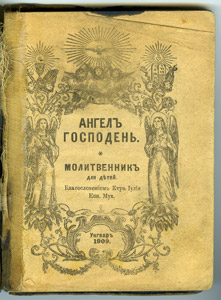
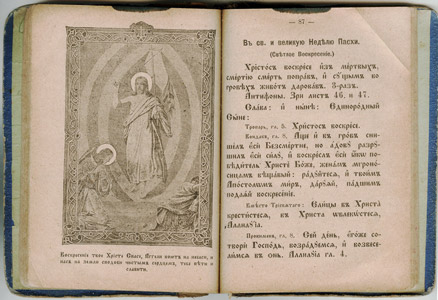 This is an early prayerbook from St.
Mary's, once owned by a parishioner in Eckley. Perhaps they, like my
grandparents and other eastern European mining families in Upper
Lehigh, walked to Freeland to attend church every Sunday. When I was a
child and attending school and church at St. Mary's, we learned to pray
in Rusyn (referred to as Porusski, which is the Slovak word for Russian
language, but in this case it was referring to Rusyn, or
Carpatho-Rusyn). The prayerbooks we received for our First Holy
Communion ("Heavenly Manna - Nebesnaja Manna," with white covers for
the girls and black ones for the boys) no longer had the
lettering in Cyrillic like this prayerbook does. We school kids sang
the mass in Porusski six days
a week. That linguistic connection to the old country was all but
obliterated when the Vatican decreed in the 1960s that Catholic masses
in the U.S. would only be celebrated in English, and that must have
felt to the older parishioners like a severe blow. The page opening
shown here is for Easter.
This is an early prayerbook from St.
Mary's, once owned by a parishioner in Eckley. Perhaps they, like my
grandparents and other eastern European mining families in Upper
Lehigh, walked to Freeland to attend church every Sunday. When I was a
child and attending school and church at St. Mary's, we learned to pray
in Rusyn (referred to as Porusski, which is the Slovak word for Russian
language, but in this case it was referring to Rusyn, or
Carpatho-Rusyn). The prayerbooks we received for our First Holy
Communion ("Heavenly Manna - Nebesnaja Manna," with white covers for
the girls and black ones for the boys) no longer had the
lettering in Cyrillic like this prayerbook does. We school kids sang
the mass in Porusski six days
a week. That linguistic connection to the old country was all but
obliterated when the Vatican decreed in the 1960s that Catholic masses
in the U.S. would only be celebrated in English, and that must have
felt to the older parishioners like a severe blow. The page opening
shown here is for Easter.

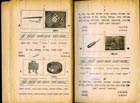
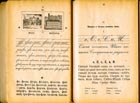 This Rusyn textbook at right was in
use in St. Mary's in the 1920s-1930s and perhaps later. The children
were taught Rusyn in school to maintain a cultural connection with the
old country. This book was given to me by a classmate, Patricia Bzdil
(now Patricia Paul). It was her mother's textbook from her own
childhood at St. Mary's. By the time I attended school there in the
1950s, we were no longer taught to read, write and speak Rusyn as a
second language. Note that this textbook and the prayerbook shown above
are both printed in Cyrillic. I'm guessing that the Slovak language
used at
St. John's Nepomucene Roman Catholic Church in prayerbooks and other
uses
would have been printed using the Roman alphabet that we're all
familiar
with, not in Cyrillic. See the Ethnic groups
page for a downloadable PDF copy of this book.
This Rusyn textbook at right was in
use in St. Mary's in the 1920s-1930s and perhaps later. The children
were taught Rusyn in school to maintain a cultural connection with the
old country. This book was given to me by a classmate, Patricia Bzdil
(now Patricia Paul). It was her mother's textbook from her own
childhood at St. Mary's. By the time I attended school there in the
1950s, we were no longer taught to read, write and speak Rusyn as a
second language. Note that this textbook and the prayerbook shown above
are both printed in Cyrillic. I'm guessing that the Slovak language
used at
St. John's Nepomucene Roman Catholic Church in prayerbooks and other
uses
would have been printed using the Roman alphabet that we're all
familiar
with, not in Cyrillic. See the Ethnic groups
page for a downloadable PDF copy of this book.